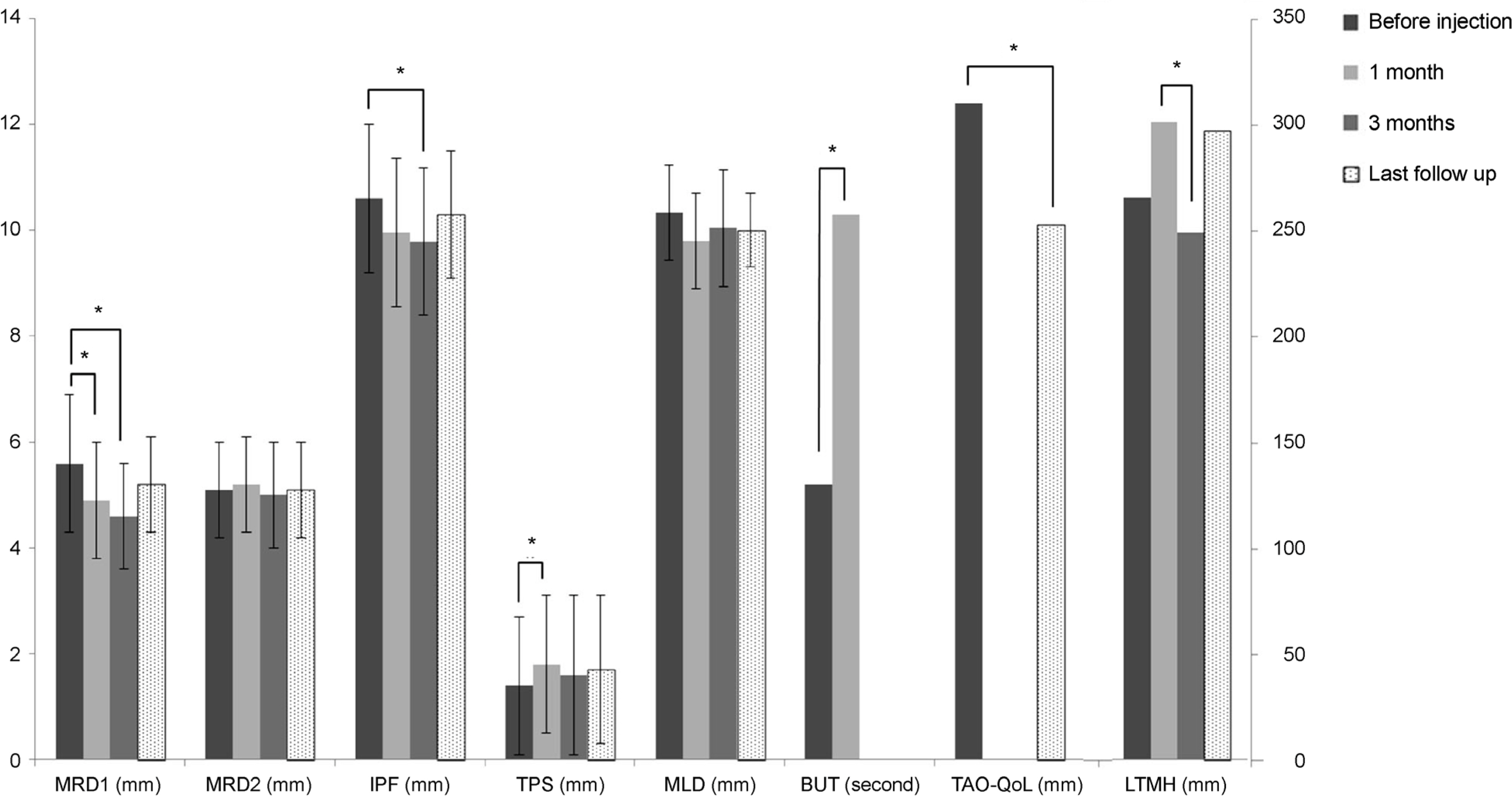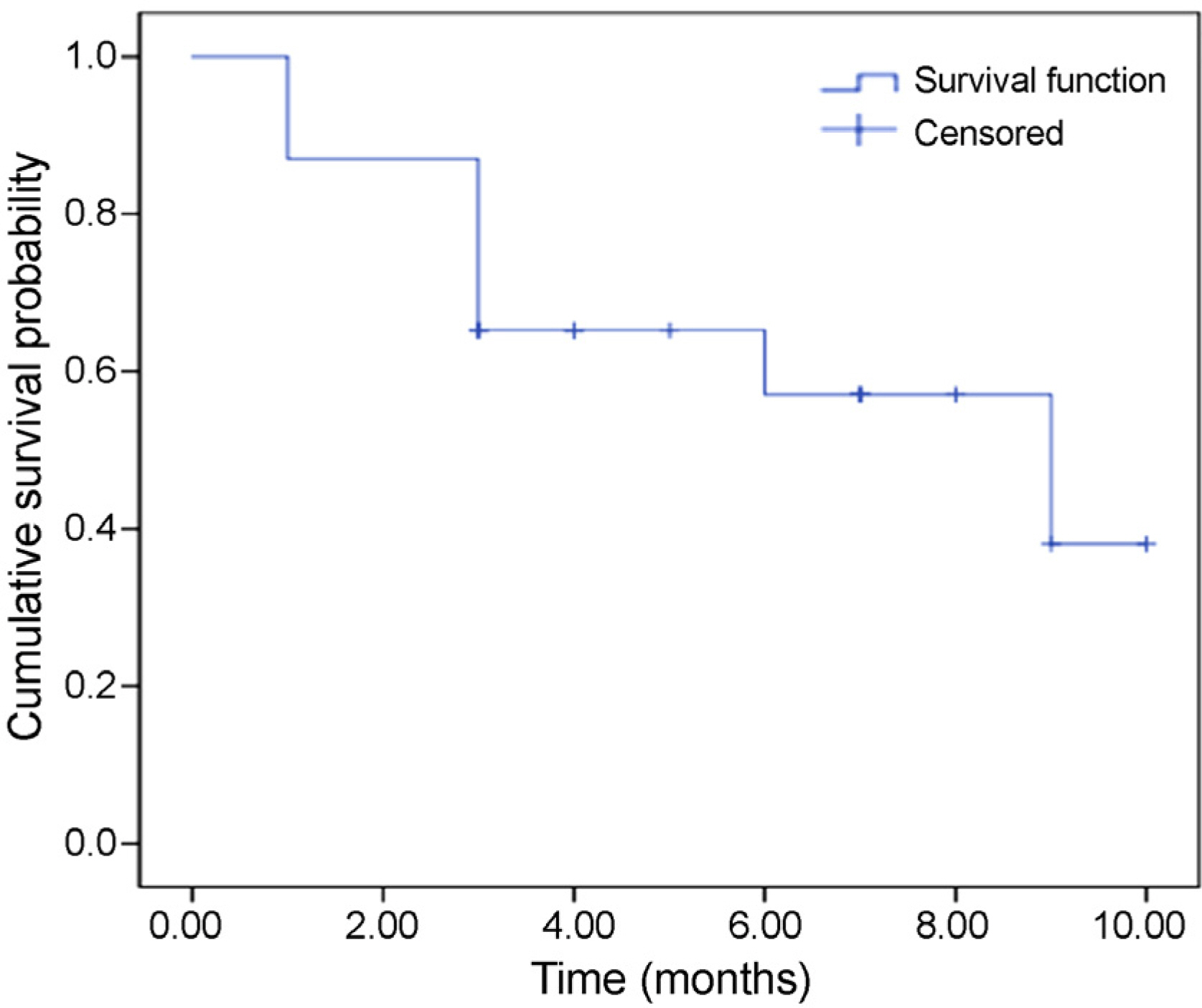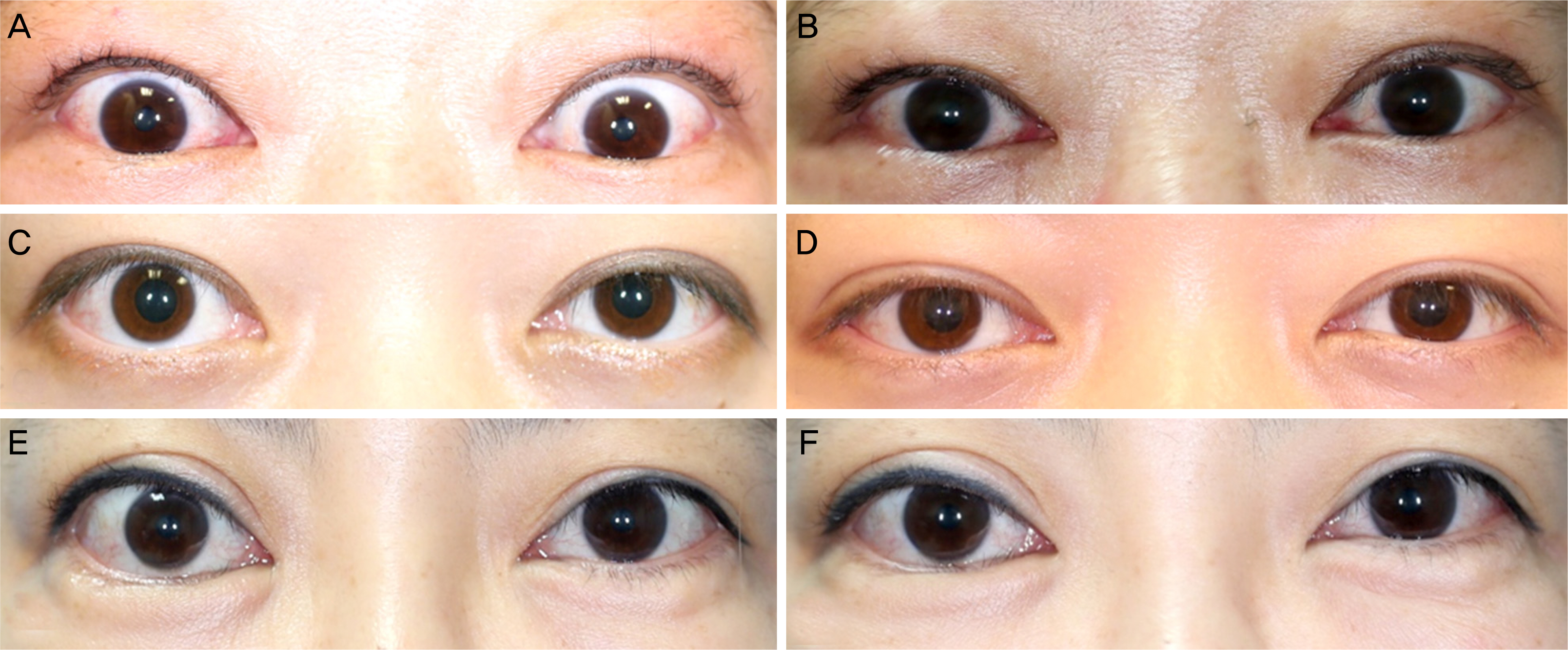J Korean Ophthalmol Soc.
2016 May;57(5):691-699. 10.3341/jkos.2016.57.5.691.
Effect of Mixed Injection of Botulinum Neurotoxin, Triamcinolone and 5-Fluorouracil in Graves' Upper Eyelid Retraction
- Affiliations
-
- 1Department of Ophthalmology, CHA Bundang Medical Center, CHA University, Seongnam, Korea. eye@cha.ac.kr
- KMID: 2212709
- DOI: http://doi.org/10.3341/jkos.2016.57.5.691
Abstract
- PURPOSE
The aim of this study is to evaluate the effects and complications of mixed injections of botulinum neurotoxin A (BoNT-A), triamcinolone acetonide, 5-fluorouracil (5-FU) in patients with Graves upper eyelid retraction.
METHODS
Twenty-four eyes of 17 patients with a mean age of 43.9 years showed symptoms of Grave's upper eyelid retraction (GUER). They received mixed injections of BoNT-A 4 IU/0.1 mL, triamcinolone acetonide 4 mg/0.1 mL and 5-FU 5 mg/0.1 mL via subconjunctival injection. The response to treatment and the presence of adverse effects were followed up for 9.0 ± 6.0 months and evaluated retrospectively.
RESULTS
Margin reflex distance 1 decreased significantly from 5.6 ± 1.2 mm to 4.7 ± 1.1 mm at 1 month after injection. Tarsal platform show increased significantly from 1.4 ± 1.3 mm to 1.8 ± 1.3 mm, and tear break up time increased significantly from 5.2 ± 3.1 seconds to 10.3 ± 7.8 seconds. When success was defined as the correction amount of GUER being larger than 1 mm, the success rate was 66.7%. Kaplan-Meier survival analysis showed that GUER correction effects last longer in patients with a duration of disease longer than 6 months. There were no severe adverse effects such as diplopia, blepharoptosis and intraocular pressure elevation.
CONCLUSIONS
Mixed injections of BoNT-A, triamcinolone acetonide and 5-FU, which compensate the side effects of solitary injection and enhances the anti-fibrotic effect, improves the eyelid position and tear film stability in the patients with GUER. It is an effective and safe method for treating GUER with long maintenance with less adverse effects.
Keyword
MeSH Terms
Figure
Reference
-
References
1. Bartley GB. Fatourechi V. Kadrmas EF, et al. Clinical features of Graves’ ophthalmopathy in an incidence cohort. Am J Ophthalmol. 1996; 121:284–90.
Article2. Costa PG. Saraiva FP. Pereira IC, et al. Comparative study of Botox injection treatment for upper eyelid retraction with 6-month follow-up in patients with thyroid eye disease in the congestive or fibrotic stage. Eye (Lond). 2009; 23:767–73.
Article3. Garrity JA. Bahn RS. Pathogenesis of graves ophthalmopathy: implications for prediction, prevention, and treatment. Am J Ophthalmol. 2006; 142:147–53.
Article4. Bahn RS. Gorman CA. Choice of therapy and criteria for assessing treatment outcome in thyroid-associated ophthalmopathy. Endocrinol Metab Clin North Am. 1987; 16:391–407.
Article5. Cockerham KP. Hidayat AA. Brown HG, et al. Clinicopathologic evaluation of the Mueller muscle in thyroid-associated orbitopathy. Ophthal Plast Reconstr Surg. 2002; 18:11–7.
Article6. Morgenstern KE. Evanchan J. Foster JA, et al. Botulinum toxin type a for dysthyroid upper eyelid retraction. Ophthal Plast Reconstr Surg. 2004; 20:181–5.
Article7. Xu D. Liu Y. Xu H. Li H. Repeated triamcinolone acetonide injection in the treatment of upper-lid retraction in patients with thyroid-associated ophthalmopathy. Can J Ophthalmol. 2012; 47:34–41.
Article8. Uddin JM. Davies PD. Treatment of upper eyelid retraction associated with thyroid eye disease with subconjunctival botulinum toxin injection. Ophthalmology. 2002; 109:1183–7.9. Jung BY. Kim YD. The results of periocular injections of triamcinolone for thyroid orbitopathy. J Korean Ophthalmol Soc. 2007; 48:1163–9.
Article10. Kim JE. Park JW. Cho JK. Yoon KC. Therapeutic effects of periocular injection of triamcinolon acetonide in patients with thyroid-associated ophthalmopathy. J Korean Ophthalmol Soc. 2011; 52:788–93.
Article11. Shih MJ. Liao SL. Lu HY. A single transcutaneous injection with Botox for dysthyroid lid retraction. Eye (Lond). 2004; 18:466–9.
Article12. Lee SJ. Rim TH. Jang SY, et al. Treatment of upper eyelid retraction related to thyroid-associated ophthalmopathy using subconjunctival triamcinolone injections. Graefes Arch Clin Exp Ophthalmol. 2013; 251:261–70.
Article13. Gebertt S. Depot-methylprednisolone for subconjunctival and retrobulbar injections. Lancet. 1961; 2:344–5.
Article14. Abraham LM. Selva D. Casson R. Leibovitch I. The clinical applications of fluorouracil in ophthalmic practice. Drugs. 2007; 67:237–55.
Article15. Gupta S. Kalra A. Efficacy and safety of intralesional 5-fluorouracil in the treatment of keloids. Dermatology. 2002; 204:130–2.
Article16. Yoo DB. Azizzadeh B. Massry GG. Injectable 5-FU with or without added steroid in periorbital skin grafting: initial observations. Ophthal Plast Reconstr Surg. 2015; 31:122–6.17. Fitzpatrick RE. Treatment of inflamed hypertrophic scars using intralesional 5-FU. Dermatologic Surg. 1999; 25:224–32.
Article18. Terwee CB. Gerding MN. Dekker FW, et al. Development of a disease specific quality of life questionnaire for patients with Graves’ ophthalmopathy: the GO-QOL. Br J Ophthalmol. 1998; 82:773–9.
Article19. Scott AB. Injection treatment of endocrine orbital myopathy. Doc Ophthalmol. 1984; 58:141–5.
Article20. Burns CL. Gammon JA. Gemmill MC. Ptosis associated with botulinum toxin treatment of strabismus and blepharospasm. Ophthalmology. 1986; 93:1621–7.
Article21. Holds JB. Alderson K. Fogg SG. Anderson RL. Motor nerve sprouting in human orbicularis muscle after botulinum A injection. Invest Ophthalmol Vis Sci. 1990; 31:964–7.22. Chee E. Chee SP. Subconjunctival injection of triamcinolone in the treatment of lid retraction of patients with thyroid eye disease: a case series. Eye (Lond). 2008; 22:311–5.
Article23. Renfro L. Snow JS. Ocular effects of topical and systemic steroids. Dermatol Clin. 1992; 10:505–12.
Article24. Chang M. Lee Y. Baek S. The functional and histopathologic change in the levator palpebrae superioris and Müller muscle after subconjunctival injection of triamcinolone acetonide. J Craniofac Surg. 2015; 26:285–9.
Article25. Said DG. Faraj LA. Elalfy MS, et al. Intra-lesional 5 fluorouracil for the management of recurrent pterygium. Eye (Lond). 2013; 27:1123–9.
Article
- Full Text Links
- Actions
-
Cited
- CITED
-
- Close
- Share
- Similar articles
-
- The Result of Botulinum Toxin A Injection in the Upper Eyelid Retraction of Thyroid-Associated Ophthalmopathy Patients
- A Case of Congenital Eyelid Retraction
- The Effect of Botulinum Toxin A Injection in the Upper Eyelid Retraction
- A Case of Primary Lipogranuloma in Eyelid
- Surgical Treatment of Thyroid-related Upper Eyelid Retraction






